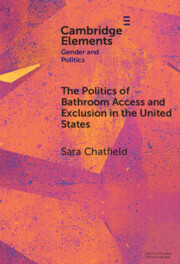Refine search
Actions for selected content:
63 results
Baseline findings from the Longitudinal Outcomes of Gender Identity in Children (LOGIC) study
-
- Journal:
- The British Journal of Psychiatry , FirstView
- Published online by Cambridge University Press:
- 04 December 2025, pp. 1-9
-
- Article
-
- You have access
- Open access
- HTML
- Export citation
Chapter 14 - Stand-Up Comedy and Trauma
- from Part III - Performance Dynamics
-
-
- Book:
- The Cambridge Companion to Stand-Up Comedy
- Published online:
- 21 August 2025
- Print publication:
- 04 September 2025, pp 273-289
-
- Chapter
- Export citation
The fixed idea of sex and the dawn of theoretical gender medicine
-
- Journal:
- Medical History / Volume 69 / Issue 3 / July 2025
- Published online by Cambridge University Press:
- 18 July 2025, pp. 413-435
-
- Article
-
- You have access
- Open access
- HTML
- Export citation
The ‘double whammy’: Associations between LGBTQ+ identity, non-standard employment and workplace well-being
- Part of
-
- Journal:
- The Economic and Labour Relations Review / Volume 36 / Issue 2 / June 2025
- Published online by Cambridge University Press:
- 27 May 2025, pp. 370-387
-
- Article
-
- You have access
- Open access
- HTML
- Export citation
“Coming Out as Female Has Been a Gradual Process”: Combating Trans Necropolitical Governance in Canadian Corrections
-
- Journal:
- Canadian Journal of Law & Society / La Revue Canadienne Droit et Société / Volume 40 / Issue 1 / April 2025
- Published online by Cambridge University Press:
- 21 May 2025, pp. 98-121
-
- Article
-
- You have access
- Open access
- HTML
- Export citation
Capturing Gender Diversity in Twin Research
-
- Journal:
- Twin Research and Human Genetics / Volume 28 / Issue 2 / April 2025
- Published online by Cambridge University Press:
- 15 April 2025, pp. 135-138
-
- Article
-
- You have access
- Open access
- HTML
- Export citation
Cultural Dynamics in Disaster Management: Exploring Sociocultural Influences on Disaster Response in Malaysia
-
- Journal:
- Disaster Medicine and Public Health Preparedness / Volume 19 / 2025
- Published online by Cambridge University Press:
- 24 March 2025, e69
-
- Article
- Export citation
Cultural Influences on Transgender Rights: Examining the Role of Religion
-
- Journal:
- Politics & Gender , First View
- Published online by Cambridge University Press:
- 24 February 2025, pp. 1-27
-
- Article
- Export citation
Case Study 1 - Gender
-
- Book:
- The Power of Brand Ownership
- Published online:
- 14 January 2025
- Print publication:
- 23 January 2025, pp 80-92
-
- Chapter
- Export citation
4 - The Role of Gender
-
- Book:
- The Power of Brand Ownership
- Published online:
- 14 January 2025
- Print publication:
- 23 January 2025, pp 63-79
-
- Chapter
- Export citation

The Politics of Bathroom Access and Exclusion in the United States
-
- Published online:
- 05 December 2024
- Print publication:
- 05 December 2024
-
- Element
- Export citation
Picture-Reading the Complexities of Transgender Experience
-
- Journal:
- Canadian Journal of Philosophy / Volume 53 / Issue 7-8 / October 2023
- Published online by Cambridge University Press:
- 22 November 2024, pp. 600-609
-
- Article
- Export citation
Enforcement agencies and an emerging category of law: examining EEOC processing of sexual orientation and gender identity charges
-
- Journal:
- Law & Society Review / Volume 58 / Issue 4 / December 2024
- Published online by Cambridge University Press:
- 14 November 2024, pp. 607-634
- Print publication:
- December 2024
-
- Article
- Export citation
7 - Imposing Sex
- from Part II - Sex
-
- Book:
- Inducing Intimacy
- Published online:
- 26 October 2024
- Print publication:
- 07 November 2024, pp 169-198
-
- Chapter
- Export citation
2 - Making Marriage
- from Part I - Marriage
-
- Book:
- Inducing Intimacy
- Published online:
- 26 October 2024
- Print publication:
- 07 November 2024, pp 29-63
-
- Chapter
- Export citation
8 - Inducing Intimacy
- from Part II - Sex
-
- Book:
- Inducing Intimacy
- Published online:
- 26 October 2024
- Print publication:
- 07 November 2024, pp 199-219
-
- Chapter
- Export citation
TRANS PARENTHOOD IN THE UK: THE “UNANSWERED QUESTIONS” OF THE MCCONNELL LITIGATION
-
- Journal:
- The Cambridge Law Journal / Volume 83 / Issue 3 / November 2024
- Published online by Cambridge University Press:
- 03 October 2024, pp. 490-518
- Print publication:
- November 2024
-
- Article
-
- You have access
- Open access
- HTML
- Export citation
Gender identity services for children and young people: navigating uncertainty through communication, collaboration and care
-
- Journal:
- The British Journal of Psychiatry / Volume 225 / Issue 2 / August 2024
- Published online by Cambridge University Press:
- 06 September 2024, pp. 302-304
- Print publication:
- August 2024
-
- Article
-
- You have access
- HTML
- Export citation
10 - Assessment, Diagnosis, and Treatment Planning for LGBTQ+ Individuals
- from Part III - Assessment and Treatment in LGBTQ+ Affirmative Counseling
-
-
- Book:
- LGBTQ+ Affirmative Counseling
- Published online:
- 31 October 2024
- Print publication:
- 04 July 2024, pp 177-196
-
- Chapter
- Export citation
7 - Historical Perspectives on Gender Identity Development
- from Part II - LGBTQ+ Lifespan Development and Family Dynamics
-
-
- Book:
- LGBTQ+ Affirmative Counseling
- Published online:
- 31 October 2024
- Print publication:
- 04 July 2024, pp 111-129
-
- Chapter
- Export citation
